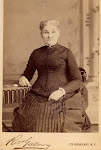

Margaret Walch was born on January 27, 1850 in Liverpool, England. She came with her family to Connecticut at the age of one and moved with them after a few years to Hastings-on-Hudson, New York, where she grew up. At about the age of 23, Margaret, who was known as Maggie, met and married Thomas William Drew, a young mason who had recently immigrated from Paignton, Devon County, England. They had two children in New York: Stephen Howard Drew in 1874 and Alfred Henry Drew in 1876.
In about 1878 the Drews moved to Caldwell Kansas and are believed to be the first in the family to have moved there. Maggie's older brother Jimmie visited them that year. Her two younger brothers, William and Isaac, also stayed with the family at about this time. By 1880 Jimmie had moved east to Cowley County and William had moved west to Harper County. In that year, only Isaac, who was known as Ike, was living with the Drew family.
In order to get a feel for their life at that time let's turn to a brief description of Caldwell, provided by the Legends of America website, www.legendsofamerica.com/ks-kansascowtowns.html:
“Caldwell, Kansas, known as the Border Queen, saw wild days as a Kansas cowtown, as well as serving as a jumping off point to the Oklahoma Land Rush days.
Located just north of the Oklahoma border, the town was established in 1871 and named in honor of United States Senator Alexander T. Caldwell, of Leavenworth, Kansas. The first building was erected by Captain C. H. Stone, one of the founders of the town site, who built a log house which was used as a store and the first post office. Stone became the fledgling city’s first postmaster. Other buildings soon followed including a hotel, other businesses, and the Red Light Saloon, which thrived with both Indian and cowboy customers.
Situated along the Chisholm Trail, the town catered to the many cowboys who passed by with their large cattle herds on their way to Abilene and Wichita. However, it remained little more than a trading post up until 1879, when it had about 260 residents.
Located just north of the Oklahoma border, the town was established in 1871 and named in honor of United States Senator Alexander T. Caldwell, of Leavenworth, Kansas. The first building was erected by Captain C. H. Stone, one of the founders of the town site, who built a log house which was used as a store and the first post office. Stone became the fledgling city’s first postmaster. Other buildings soon followed including a hotel, other businesses, and the Red Light Saloon, which thrived with both Indian and cowboy customers.
Situated along the Chisholm Trail, the town catered to the many cowboys who passed by with their large cattle herds on their way to Abilene and Wichita. However, it remained little more than a trading post up until 1879, when it had about 260 residents.
However, when the Santa Fe Railroad extended its line to Caldwell, Wichita investors soon took notice and formed a town company in 1879, selling lots for $125. The city was soon incorporated and quickly promoted its opportunity as a cattle shipping point. The town grew quickly and soon boasted some 1,500 people.
As the cowboys began to drive the cattle up the Chisholm Trail to Caldwell, the town took on all of the elements of a lawless frontier settlement. These many drovers gave the town its nickname, the "Border Queen."
As the town sprouted saloons, gambling dens, and brothels, the first town north of Indian Territory, provided a place where the cowboys could go wild after months on the dusty and treacherous trail. Gunfights, showdowns, general hell raising and hangings soon became commonplace.
During its reckless cowtown period between 1879 and 1885, Caldwell “boasted” a higher murder rate, and loss of more law enforcement officers than other more famous cowtowns. During this period, violence claimed the lives of 18 city marshals, leading a Wichita editor to write, "As we go to press hell is again in session in Caldwell."’
The 1880 photo of Caldwell above is from the of Legends of America website.




















